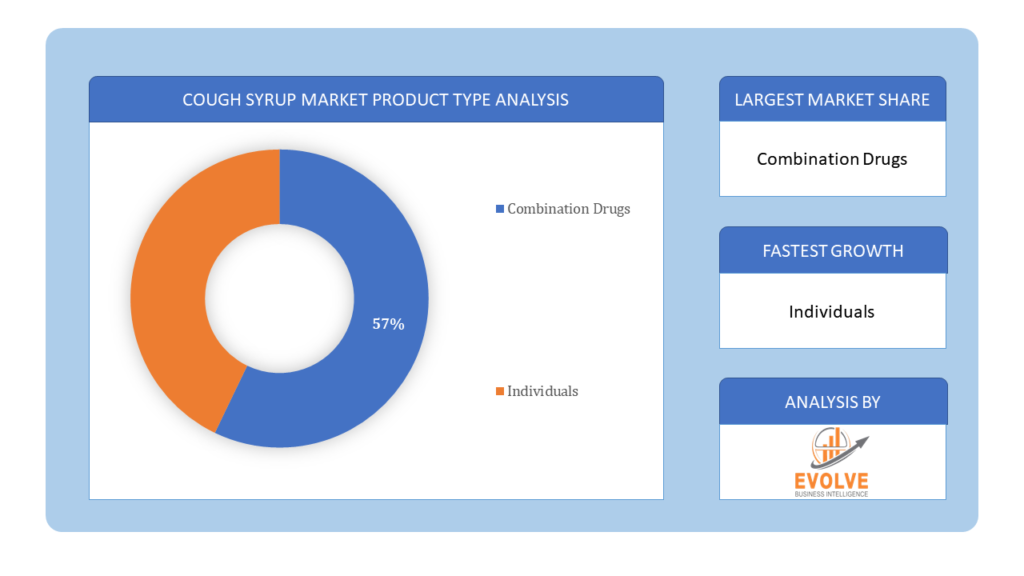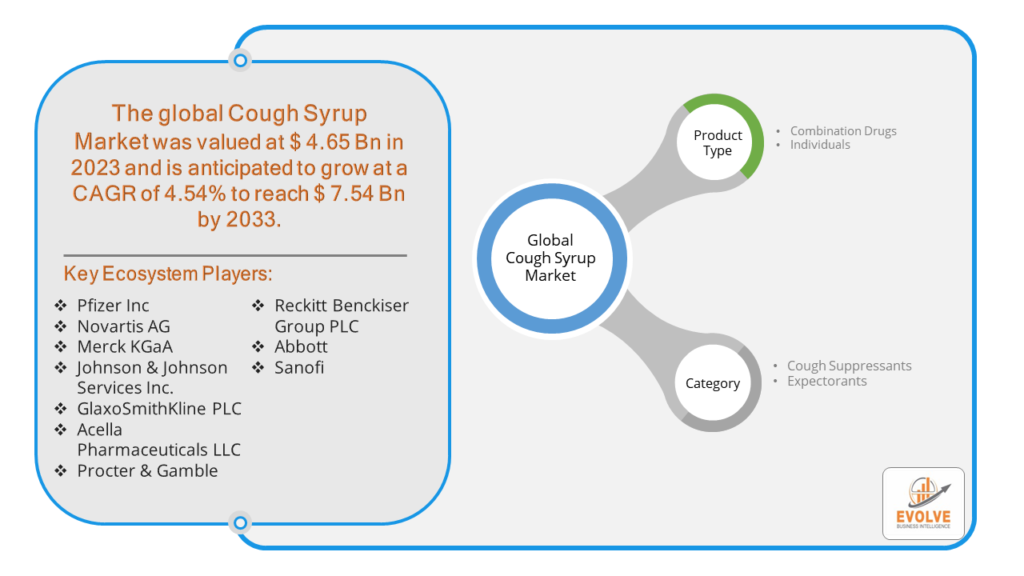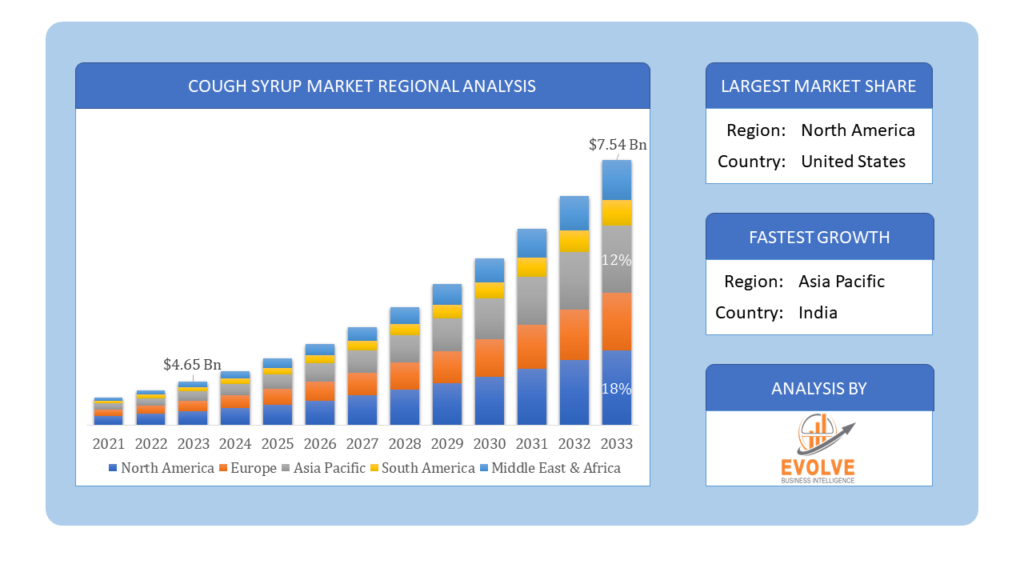Cough Syrup Market Overview
The Cough Syrup Market Size is expected to reach USD 7.54 Billion by 2033. The Cough Syrup Market industry size accounted for USD 4.65 Billion in 2023 and is expected to expand at a compound annual growth rate (CAGR) of 4.54% from 2023 to 2033. The Cough Syrup Market refers to the global industry involved in the production, distribution, and sale of cough syrups, which are liquid medications used to relieve coughing and related symptoms often caused by colds, flu, allergies, or other respiratory conditions.
The cough syrup market is driven by a number of factors, including the rising incidence of respiratory diseases, the growing awareness of self-medication, and the increasing demand for convenient and effective cough treatments. However, the market is also challenged by the strict regulatory environment for cough syrups, the availability of generic alternatives, and the potential for side effects.
Global Cough Syrup Market Synopsis
The The COVID-19 pandemic had a significant impact on the Cough Syrup Market. During the early stages of the pandemic, many consumers engaged in panic buying of over-the-counter medications, including cough syrups, leading to short-term spikes in sales. Lockdowns and restrictions affected manufacturing capabilities, leading to delays and shortages in the supply of cough syrups. Transportation and distribution networks faced significant disruptions, impacting the availability of products in various regions. The pandemic heightened awareness about health and hygiene, leading to more cautious and informed purchasing decisions regarding medications. There was also a focus on ensuring the quality and safety of medications, leading to stricter regulatory oversight. While there was an initial surge in sales, the long-term economic impact of the pandemic, including reduced consumer spending power, influenced market revenue. Increased investment in the healthcare sector overall could have positive spillover effects on the cough syrup market.
Cough Syrup Market Dynamics
The major factors that have impacted the growth of Cough Syrup Market are as follows:
Drivers:
Ø Technological and Product Innovation
Development of new formulations, flavors, and packaging enhances consumer appeal and efficacy. Increased investments in research and development lead to the introduction of more effective and safer cough syrups. Increasing consumer awareness about health and the benefits of early treatment drives the market. More consumers are opting for OTC medications for minor ailments, including coughs and colds. Increased exposure to pollutants and allergens in urban areas contributes to higher incidences of cough and respiratory issues. Modern lifestyle factors, such as smoking and stress, can lead to respiratory problems, increasing demand for cough syrups.
Restraint:
- Perception of Health and Safety Concerns
Adverse effects, such as drowsiness, dizziness, or allergic reactions, can limit the use of certain cough syrups. Overuse or misuse of cough syrups, particularly those containing codeine or dextromethorphan, can lead to dependency or abuse, raising safety concerns. High competition from numerous players, including generic and branded products, can pressure pricing and profitability. Availability of alternative treatments, such as herbal remedies and prescription medications, can reduce demand for traditional cough syrups. Increasing preference for natural and home remedies over synthetic cough syrups can negatively impact market demand.
Opportunity:
⮚ Growing demand for Digital and E-Commerce Growth
Leveraging the growth of e-commerce platforms to sell cough syrups directly to consumers can increase accessibility and convenience. Collaborating with telemedicine providers to recommend and sell cough syrups can boost sales and reach. Emphasizing the role of cough syrups in preventive health measures can align with the growing consumer focus on wellness and proactive healthcare. Combining cough syrups with ingredients that support immune health can attract health-conscious consumers. Adopting sustainable and environmentally friendly practices in manufacturing and packaging can appeal to eco-conscious consumers.
Cough Syrup Market Segment Overview
By Product Type
 Based on Product Type, the market is segmented based on Combination Drugs and Individuals. The Combination Drugs segment dominant the market. It contains a mix of active ingredients designed to address multiple symptoms simultaneously. Higher prevalence of colds, flu, and other respiratory infections boosts demand for combination drugs.
Based on Product Type, the market is segmented based on Combination Drugs and Individuals. The Combination Drugs segment dominant the market. It contains a mix of active ingredients designed to address multiple symptoms simultaneously. Higher prevalence of colds, flu, and other respiratory infections boosts demand for combination drugs.
By Category
Based on Category, the market segment has been divided into the Cough Suppressants and Expectorants. The cough suppressants segment dominates the market, due to the wide range of awareness and applications for cough syrups as a medication for cough. Cough syrups are predominantly considered for wet and dry coughs, though all of its other benefits are secondary and not known well. It is also the most commonly available dextromethorphan at pharmacies or stores.
Global Cough Syrup Market Regional Analysis
Based on region, the global Cough Syrup Market has been divided into North America, Europe, Asia-Pacific, the Middle East & Africa, and Latin America. North America is projected to dominate the use of the Cough Syrup Market followed by the Asia-Pacific and Europe regions.
 Cough Syrup North America Market
Cough Syrup North America Market
North America holds a dominant position in the Cough Syrup Market. This region is a mature market for cough syrups, but it is still expected to see some growth. The factors driving this growth include high disposable income of consumers allowing them to afford cough syrups. Increasing awareness of self-medication and focus on home healthcare and Presence of major pharmaceutical companies in the region.
Cough Syrup Asia-Pacific Market
The Asia-Pacific region has indeed emerged as the fastest-growing market for the Cough Syrup Market industry. This region holds the largest share of the cough syrup market and is expected to maintain its dominance. This is due to several factors like large and growing population, especially the geriatric population which is more susceptible to respiratory ailments. Easier availability of cough syrups over-the-counter in many countries within the region and Less stringent regulations on cough syrup sales compared to some other regions.
Competitive Landscape
The global Cough Syrup Market is highly competitive, with numerous players offering a wide range of software solutions. The competitive landscape is characterized by the presence of established companies, as well as emerging startups and niche players. To increase their market position and attract a wide consumer base, the businesses are employing various strategies, such as product launches, and strategic alliances.
Prominent Players:
- Pfizer Inc
- Novartis AG
- Merck KGaA
- Johnson & Johnson Services Inc.
- GlaxoSmithKline PLC
- Acella Pharmaceuticals LLC
- Procter & Gamble
- Reckitt Benckiser Group PLC
- Abbott
- Sanofi
Key Development
In April 2024, The World Health Organization (WHO) issued a broader alert regarding contaminated children’s cough syrup produced by Johnson and Johnson in response to the discovery of tainted batches in Nigeria.
In March 2024, Nin Jiom, one of the Hong Kong-based companies known for its cough syrup product Pei Pa Koa, is venturing into the healthy aging supplement space with a nicotinamide mononucleotide (NMN) product set to launch in Singapore.
In November 2023, Himalaya Wellness Company announced the launch of Himalaya Koflet’s 360-degree advertising campaign to enhance brand awareness.
Scope of the Report
Global Cough Syrup Market, by Product Type
- Combination Drugs
- Individuals
Global Cough Syrup Market, by Category
- Cough Suppressants
- Expectorants
Global Cough Syrup Market, by Region
- North America
- US
- Canada
- Mexico
- Europe
- UK
- Germany
- France
- Italy
- Spain
- Benelux
- Nordic
- Rest of Europe
- Asia Pacific
- China
- Japan
- South Korea
- Indonesia
- Austalia
- Malaysia
- India
- Rest of Asia Pacific
- South America
- Brazil
- Argentina
- Rest of South America
- Middle East & Africa
- Saudi Arabia
- UAE
- Egypt
- South Africa
- Rest of Middle East & Africa
| Parameters | Indicators |
|---|---|
| Market Size | 2033: $7.54 Billion |
| CAGR | 4.54% CAGR (2023-2033) |
| Base year | 2022 |
| Forecast Period | 2023-2033 |
| Historical Data | 2021 |
| Report Coverage | Revenue Forecast, Competitive Landscape, Growth Factors, and Trends |
| Key Segmentations | Product Type, Category |
| Geographies Covered | North America, Europe, Asia-Pacific, Latin America, Middle East, Africa |
| Key Vendors | Pfizer Inc, Novartis AG, Merck KGaA, Johnson & Johnson Services Inc., GlaxoSmithKline PLC, Acella Pharmaceuticals LLC, Procter & Gamble, Reckitt Benckiser Group PLC, Abbott and Sanofi |
| Key Market Opportunities | • The growing demand for Digital and E-Commerce Growth • Environmental and Sustainability Initiatives |
| Key Market Drivers | • Technological and Product Innovation • Environmental and Lifestyle Factors |
REPORT CONTENT BRIEF:
- High-level analysis of the current and future Cough Syrup Market trends and opportunities
- Detailed analysis of current market drivers, restraining factors, and opportunities in the future
- Cough Syrup Market historical market size for the year 2021, and forecast from 2023 to 2033
- Cough Syrup Market share analysis at each product level
- Competitor analysis with detailed insight into its product segment, Government & Defense strength, and strategies adopted.
- Identifies key strategies adopted including product launches and developments, mergers and acquisitions, joint ventures, collaborations, and partnerships as well as funding taken and investment done, among others.
- To identify and understand the various factors involved in the global Cough Syrup Market affected by the pandemic
- To provide a detailed insight into the major companies operating in the market. The profiling will include the Government & Defense health of the company’s past 2-3 years with segmental and regional revenue breakup, product offering, recent developments, SWOT analysis, and key strategies.







